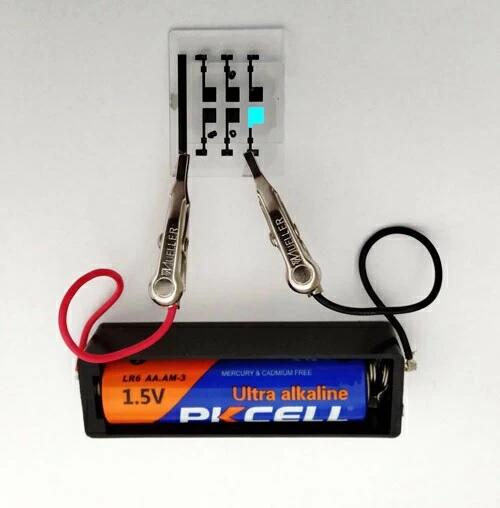A research group led by Associate Professor Seiichiro Izawa of the Laboratory for Materials and Structures (MSL) at the Institute of Innovative Research at the Tokyo Institute of Technology (Tokyo Tech), and of the Joining and Welding Research Institute (JWRI) at Osaka University, Associate Professor Masahiro Morimoto of the Faculty of Engineering at the University of Toyama, and Assistant Professor Keisuke Fujimoto of the College of Engineering at Shizuoka University announced that it has succeeded in developing a blue organic light-emitting diode (OLED) that emits light at the lowest voltage ever reported (1.5 V) by simply connecting to a single dry-cell battery. The developed OLED emits blue light at 462 nm from 1.26 V and reaches display-quality luminance at 1.97 V.
Considering that the blue light emitting device glows at the lowest voltage ever reported, this achievement is expected to be useful for energy savings in OLED TVs, smartphone displays, and other electronic products. The results were published in the September 20, 2023 issue of Nature Communications.

Provided by Tokyo Institute of Technology
OLEDs have practical applications in TVs and smartphone displays but require high drive voltages and consume large amounts of power. In particular, obtaining blue light, which has a higher energy than red or green light and generally requires a voltage of approximately 4 V, is extremely challenging.
In this study, the research group successfully developed a blue OLED that glows at an ultralow voltage using an original light-emission principle in which an upconversion process (i.e., a process that creates a high-energy excited state from a low-energy excited state) occurs at the interface between two types of organic molecules.
To verify the stability of the developed device, the research group compared the decrease in its luminance when continuously driven at an emission luminance of 1000 cd/m² with that of a previously reported blue phosphorescent OLED device. Consequently, the life of the device was found to be approximately 90 times longer than that of conventional blue phosphorescent devices. Because blue light has a large optical energy, it tends to cause the decomposition of organic molecules that emit light and have low stability. In contrast, the luminescence mechanism of the developed device derives blue light from low-energy triplet excitons, which is advantageous in terms of stability.
The development of a new technology that can significantly reduce the drive voltage of blue OLEDs, which consume more display power than red or green OLED, indicates a significant advancement in reducing the power consumption of display devices using OLEDs, such as TVs and smartphones.
In the future, the research group aims to achieve blue light emission with a narrower spectral width and higher color purity at lower voltages to enable the application of this technology to display devices. It is also expected that changing the emission color to white can lead to the development of white OLED lighting that can emit light at ultralow voltages.
Izawa stated, "We have achieved blue luminescence at ultralow voltages using our original luminescence principle, but we encountered challenges in identifying the molecules that generate this luminescence. The key to this luminescence mechanism is the interface between two types of molecules. By clarifying the nature of this interface, we were able to identify a combination of molecules that produces low-voltage and highly efficient blue luminescence. In the future, we aim to develop OLEDs that emit blue light with higher color purity at lower voltages for display applications."
Journal Information
Publication: Nature Communications
Title: Blue organic light-emitting diode with a turn-on voltage of 1.47 V
DOI: 10.1038/s41467-023-41208-7
This article has been translated by JST with permission from The Science News Ltd. (https://sci-news.co.jp/). Unauthorized reproduction of the article and photographs is prohibited.




